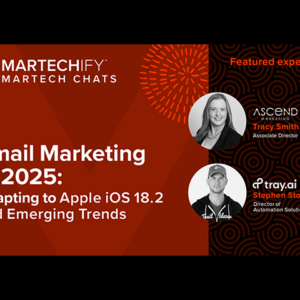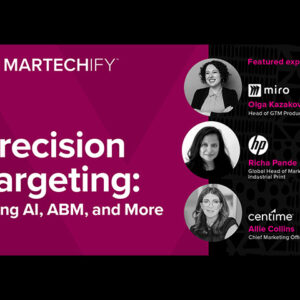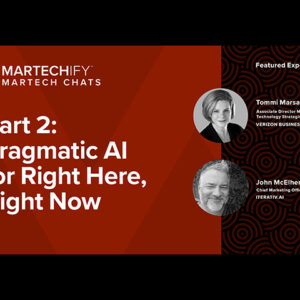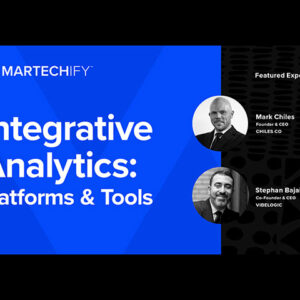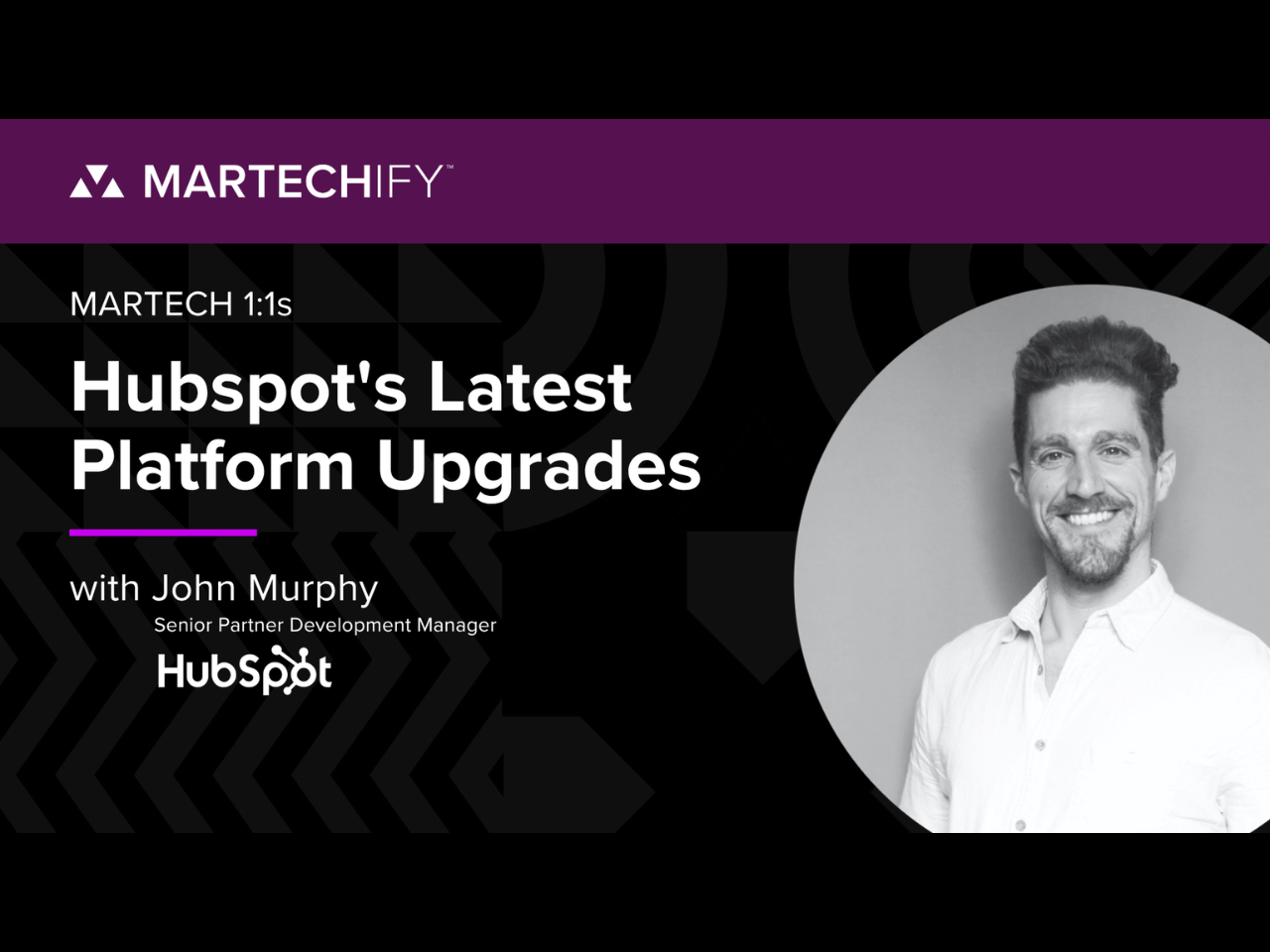Harnessing AI in Market Research: How to Enhance Your Martech Stack in 2025
- Rebecca Farabaugh, former Executive Director, Allegheny Health Network,
- Other Martech, Strategy and Trends
Is one of your 2025 marketing goals to use technology to understand your customers better? In a world where AI is reshaping nearly every aspect of market research, the question is no longer if AI can transform how we gather insights but how to balance its powerful capabilities with the irreplaceable human touch.
We recently interviewed Rebecca Farabaugh, former Executive Director at Allegheny Health Network, and discovered how AI-driven market research can enhance martech stacks in 2025—while keeping human insight at its core. “The possibilities are expanding rapidly,” says Farabaugh, who has witnessed the evolution of market research tools throughout her career. “We’re seeing AI enhance everything from survey design to data analysis, but what’s really exciting is the emergence of virtual research participants.”
This development—using AI to create interactive personas that respond in real-time to researcher questions—represents a significant shift in how organizations can gather and process market insights. But Farabaugh emphasizes that these tools should augment, not replace, traditional research methods.
We recently interviewed Rebecca Farabaugh, former Executive Director at Allegheny Health Network, and discovered how AI-driven market research can enhance martech stacks in 2025—while keeping human insight at its core. “The possibilities are expanding rapidly,” says Farabaugh, who has witnessed the evolution of market research tools throughout her career. “We’re seeing AI enhance everything from survey design to data analysis, but what’s really exciting is the emergence of virtual research participants.”
This development—using AI to create interactive personas that respond in real-time to researcher questions—represents a significant shift in how organizations can gather and process market insights. But Farabaugh emphasizes that these tools should augment, not replace, traditional research methods.
The multiple fronts of AI transformation in survey methodologies
The transformation is happening on multiple fronts. Survey tools have become more sophisticated, allowing researchers to gather deeper insights from larger populations. Virtual focus group platforms have eliminated geographical barriers, enabling organizations to connect with participants from anywhere in the world. But it’s the integration of AI that’s creating the most dramatic changes.
“AI is helping us write better surveys and analyze data more effectively,” Farabaugh explains. “This isn’t new—we’ve been using AI for these purposes for some time. What’s revolutionary is the potential to build virtual personas that can interact directly with researchers.”
These AI-powered personas are trained on vast amounts of real consumer data, allowing them to respond authentically to questions about preferences, behaviors, and decision-making processes. The technology could potentially provide researchers with 24/7 access to consumer insights, dramatically accelerating the research process.
“AI is helping us write better surveys and analyze data more effectively,” Farabaugh explains. “This isn’t new—we’ve been using AI for these purposes for some time. What’s revolutionary is the potential to build virtual personas that can interact directly with researchers.”
These AI-powered personas are trained on vast amounts of real consumer data, allowing them to respond authentically to questions about preferences, behaviors, and decision-making processes. The technology could potentially provide researchers with 24/7 access to consumer insights, dramatically accelerating the research process.
Balancing AI with human insight: An example
However, Farabaugh cautions against over-reliance on technology. “There’s always concern about utilizing tools to maximize and optimize impact without losing that skill set and ability to interpret as a person,” she notes. This balance between technological capability and human insight sits at the heart of modern market research.
Traditional qualitative research methods—such as focus groups, one-on-one interviews, and observational studies—remain valuable tools in the researcher’s arsenal. The key lies in knowing when to leverage AI and when to rely on human-to-human interaction.
The power of combining AI with human insight becomes clear when examining real-world applications. Farabaugh shares an example from her experience working with a utility company, where she used both AI-powered analytics and traditional human-centered research methods to understand employee perspectives on customer centricity.
“We started with quantitative research, using AI to analyze survey responses from across the company,” she explains. “The AI helped us identify patterns and pockets of lower scores, but understanding the ‘why’ behind those numbers required human connection.” The research team followed up with focus groups and human-centered design methodologies, allowing them to uncover the emotional and contextual factors that pure data analysis might have missed.
“That 62% satisfaction rate translated into actual experiences and feelings that employees were having,” Farabaugh notes. “No AI system, no matter how sophisticated, could have captured those nuances on its own.”
Traditional qualitative research methods—such as focus groups, one-on-one interviews, and observational studies—remain valuable tools in the researcher’s arsenal. The key lies in knowing when to leverage AI and when to rely on human-to-human interaction.
The power of combining AI with human insight becomes clear when examining real-world applications. Farabaugh shares an example from her experience working with a utility company, where she used both AI-powered analytics and traditional human-centered research methods to understand employee perspectives on customer centricity.
“We started with quantitative research, using AI to analyze survey responses from across the company,” she explains. “The AI helped us identify patterns and pockets of lower scores, but understanding the ‘why’ behind those numbers required human connection.” The research team followed up with focus groups and human-centered design methodologies, allowing them to uncover the emotional and contextual factors that pure data analysis might have missed.
“That 62% satisfaction rate translated into actual experiences and feelings that employees were having,” Farabaugh notes. “No AI system, no matter how sophisticated, could have captured those nuances on its own.”
Leveraging the strengths of both human and AI components
This hybrid approach represents the future of market research. For example, AI excels at:
— Processing large volumes of data quickly
— Identifying patterns and trends
— Generating initial insights
— Predicting consumer behavior based on historical data
— Automating routine analysis tasks
Meanwhile, human researchers bring:
— Emotional intelligence and empathy
— Cultural understanding
— Critical thinking and context
— Creative problem-solving
— Ethical considerations in research design
The key to success lies in leveraging each component’s strengths. For example, AI can analyze thousands of survey responses to identify trending topics, while human researchers can design thoughtful follow-up questions that dig deeper into underlying motivations.
“What makes human beings human is our ability to make meaning,” Farabaugh emphasizes. “Technology can help us gather and process information, but interpreting that information and giving it meaning remains a distinctly human capability.”
Organizations looking to modernize their market research approach should focus on building systems that facilitate this collaboration between AI and human insight. This might include:
— Investing in AI-powered analytics platforms
— Training researchers to work effectively with AI tools
— Maintaining strong qualitative research capabilities
— Developing frameworks for integrating AI and human insights
— Regular evaluation of which tasks are best suited for each approach
— Processing large volumes of data quickly
— Identifying patterns and trends
— Generating initial insights
— Predicting consumer behavior based on historical data
— Automating routine analysis tasks
Meanwhile, human researchers bring:
— Emotional intelligence and empathy
— Cultural understanding
— Critical thinking and context
— Creative problem-solving
— Ethical considerations in research design
The key to success lies in leveraging each component’s strengths. For example, AI can analyze thousands of survey responses to identify trending topics, while human researchers can design thoughtful follow-up questions that dig deeper into underlying motivations.
“What makes human beings human is our ability to make meaning,” Farabaugh emphasizes. “Technology can help us gather and process information, but interpreting that information and giving it meaning remains a distinctly human capability.”
Organizations looking to modernize their market research approach should focus on building systems that facilitate this collaboration between AI and human insight. This might include:
— Investing in AI-powered analytics platforms
— Training researchers to work effectively with AI tools
— Maintaining strong qualitative research capabilities
— Developing frameworks for integrating AI and human insights
— Regular evaluation of which tasks are best suited for each approach
Looking ahead at AI’s role in research
Looking ahead, market research will continue to evolve as AI capabilities expand. But rather than fearing technological displacement, researchers should focus on developing skills that complement AI capabilities.
“We want to utilize these tools to maximize and optimize the impact we can have,” Farabaugh explains, “but we never want to get so reliant on them that we’re losing that skill set and ability to understand people as a person.”
The next wave of innovation will likely include advanced natural language processing, predictive analytics enhancement, and real-time insight generation.
Advanced natural language processing
AI systems will become even better at understanding and analyzing open-ended responses, but human researchers will remain essential for interpreting contextual nuances and cultural subtleties.
Predictive analytics enhancement
While AI will offer increasingly accurate predictions about consumer behavior, human insight will be crucial for understanding outliers and adapting to unprecedented market changes.
Real-time insight generation
AI will enable instant analysis of consumer feedback, but human researchers will need to validate these insights and ensure they align with broader business objectives.
For organizations preparing for this future, Farabaugh recommends focusing on three key areas:
1. Team development
Build research teams that combine technical expertise with strong interpersonal skills.
“The insight space is this great intersection where we really keep the value of having the human voice involved no matter how great the tools get,” Farabaugh notes.
2. Process integration
Develop workflows that seamlessly combine AI analysis with human interpretation. This might mean using AI for initial data analysis, then having human researchers design and conduct follow-up investigations.
3. Continuous learning
Stay current with emerging technologies while deepening traditional research skills. Understanding both aspects will become increasingly valuable.
“The future of market research lies in this balance,” Farabaugh concludes. “It’s not about choosing between AI and human insight—it’s about understanding how to use both effectively to generate deeper, more meaningful insights.”
Success in this evolving landscape will depend on organizations’ ability to embrace technological advancement while preserving the human elements that make research meaningful. Those who can strike this balance will be best positioned to understand and serve their markets effectively.
As AI continues to transform market research, the role of human researchers won’t diminish—it will evolve. The most successful organizations will be those that recognize this shift and invest in both technological capabilities and human expertise. After all, as Farabaugh reminds us, at the heart of every insight is a human story waiting to be understood and told.
“We want to utilize these tools to maximize and optimize the impact we can have,” Farabaugh explains, “but we never want to get so reliant on them that we’re losing that skill set and ability to understand people as a person.”
The next wave of innovation will likely include advanced natural language processing, predictive analytics enhancement, and real-time insight generation.
Advanced natural language processing
AI systems will become even better at understanding and analyzing open-ended responses, but human researchers will remain essential for interpreting contextual nuances and cultural subtleties.
Predictive analytics enhancement
While AI will offer increasingly accurate predictions about consumer behavior, human insight will be crucial for understanding outliers and adapting to unprecedented market changes.
Real-time insight generation
AI will enable instant analysis of consumer feedback, but human researchers will need to validate these insights and ensure they align with broader business objectives.
For organizations preparing for this future, Farabaugh recommends focusing on three key areas:
1. Team development
Build research teams that combine technical expertise with strong interpersonal skills.
“The insight space is this great intersection where we really keep the value of having the human voice involved no matter how great the tools get,” Farabaugh notes.
2. Process integration
Develop workflows that seamlessly combine AI analysis with human interpretation. This might mean using AI for initial data analysis, then having human researchers design and conduct follow-up investigations.
3. Continuous learning
Stay current with emerging technologies while deepening traditional research skills. Understanding both aspects will become increasingly valuable.
“The future of market research lies in this balance,” Farabaugh concludes. “It’s not about choosing between AI and human insight—it’s about understanding how to use both effectively to generate deeper, more meaningful insights.”
Success in this evolving landscape will depend on organizations’ ability to embrace technological advancement while preserving the human elements that make research meaningful. Those who can strike this balance will be best positioned to understand and serve their markets effectively.
As AI continues to transform market research, the role of human researchers won’t diminish—it will evolve. The most successful organizations will be those that recognize this shift and invest in both technological capabilities and human expertise. After all, as Farabaugh reminds us, at the heart of every insight is a human story waiting to be understood and told.


